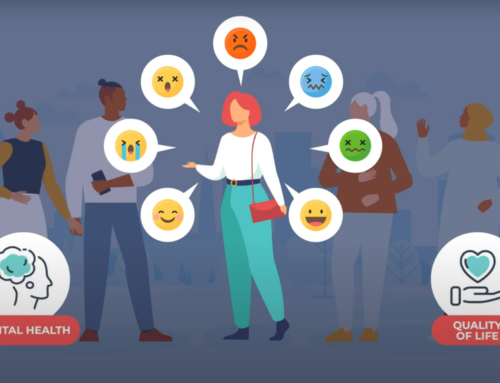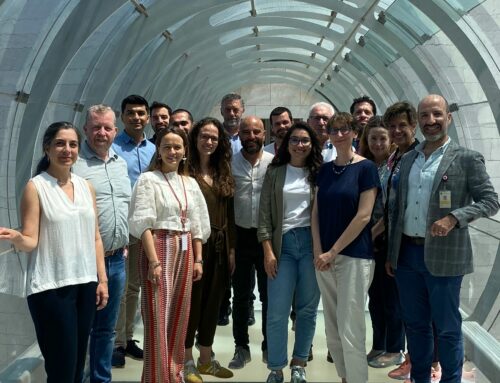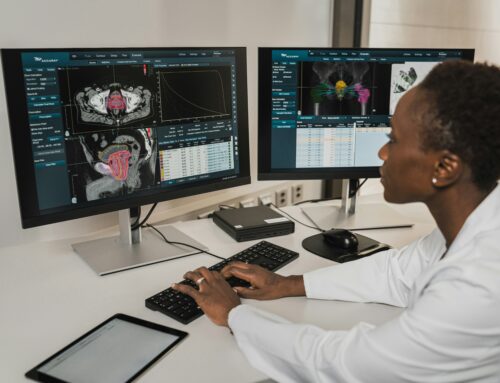Exercise is a very effective way to prevent the insurgence of different non-transmissible diseases, such as type 2 diabetes, cardiovascular diseases, obesity, or cancer. All these conditions are related to an increased risk of premature death. Concretely, the World Health Organization has estimated that 150 minutes per week of moderate physical activity, or 75 minutes per week of vigorous physical activity, are related with better levels of health and lower risk of chronic disease. In addition, different studies have already established that a combination of cardiovascular and strength activities can help achieve an integrative impact in physical and metabolic health.
Regarding cancer, a meta-analysis showed how, with exercise integration, there is a 20% risk reduction in oesophageal, liver, lung, kidney, endometrial and gastric cancer. Moreover, a 10-20% risk reduction was also observed in colon, myeloma, head and neck, bladder, and breast cancer. Certainly, this suggests that there are different underlying physiological adaptations that are protective against cancer. Despite all of this, the Spanish population presents high levels of inactivity, which is the fourth cause of death in the whole world. Indeed, 31.3% of the total population is sedentary, and around 40% of them do not perform enough physical activity.
Physical activity’s impact on cancer
Benefits of exercise on cancer patients have been well observed: lower levels of toxicity during treatments, milder side effects, faster physical recovery, and better tolerability to treatment side effects. After treatment, physically active patients have lower levels of co-morbidities and reduced risk of cancer and all-causes death. This is mostly due to exercise limiting the risk of cardiac and metabolic diseases. Notably, one of cancer treatment’s most common side effects are changes in body composition. Increased weight and fat mass are related to higher risk of recurrence. On the other hand, reduced muscle mass is related with higher levels of toxicity and fatigue, one of the most common and limiting side effects.
Another important consequence of cancer treatment is the reduction in physical exercise capacity. This variable is an independent predictor of survival, as well as of other metabolic and cardiac diseases. In fact, such is its relevance that reduced physical capacity increases the risk of death from cancer and all causes. In addition, specific physical interventions reduce other disorders such as physical impairment, or lymphoedema. This is due to the improvements in muscle and joint mobility, as well as in the circulatory and lymphatic system or prevention of overweight and obesity.
However, the benefits of exercise are not only physical, but also physiological. Reductions in pro-inflammatory biomarkers, including cytokines such as IL-6, TNF-alpha or C-reactive protein, have been observed after different aerobic exercise routines. Going further, other important physiological changes include increased immune system function, improvements in different metabolic pathways, such as insulin and IGF-1 production, or reduced levels of sex hormones, which are of particular importance in some types of cancer such as breast or ovarian cancer.
Cancer Care in Young Adults
Young adults with cancer are defined as people between 18 to 45 years old with a new cancer diagnosis, accounting for about 3% in women and 1.9% in men of all new diagnoses, with an upward trend. Oftentimes, as a consequence of the young age, this population receives more aggressive cancer treatments. Reasonably, this has a greater impact on their long-term health and co-morbidities (i.e. cardiovascular disease, type 2 diabetes, or metabolic syndrome). Moreover, stronger side effects are responsible for reducing young and adult cancer patients’ life expectancy, besides worsening their health and well-being. Furthermore, this situation has a significant impact on the social, family, and economic structures of these patients. It translates into a reduction of patients’ and their families’ economic capacity, a negative impact on social productivity and, consequently, a devaluation of the status and social structures of this population.
Exercise-oncology is an integrative strategy that presents particular importance in this type of patients, improving their health during and beyond cancer. First of all, physical activity may prevent physical and physiological impairments during cancer treatments. Secondly, it may help recover physical limitations that may appear after surgery or breast reconstruction. Finally, exercise may reduce the risk of changes in body composition and fitness capacity. Furthermore, many studies demonstrated the positive effects of regular exercise on mental health, even during the pandemic’s many intermittent lockdowns. For instance, physically active people had less chance of manifesting poor mental health conditions, compared to those who didn’t exercise regularly.
Indeed, Covid-19 restrictions will have a lasting impact on cancer patients’ health, still to be discovered. In this regard, changes in body composition and reduced fitness capacity may be associated with an increased risk of both recurrence and cardiovascular diseases. Especially in young adults with cancer, these changes can negatively affect their social, economic and familial environment more than older patients’. For this reason, exercise becomes an essential tool to regain previous body composition and healthy fitness capacity, reducing the risk of cancer and overall mortality. Despite the known benefits, young oncological patients still report physical exercise reduction after diagnosis, and mainly during cancer treatments.
Research in exercise’s impact on cancer: FAITH & YOUNG MOVE
Tapping from the knowledge on physical exercise’s benefits, FAITH’s digital solution will collect data on patients’ physical activity, regarding it as a marker for mental health well-being, for physical activity can display important hints on one’s outlook. Specifically, FAITH combines data gathering of various depression-related markers and proactive Quality of Life (QoL) questionnaires. Then, using an AI-based App, FAITH will remotely monitor patients’ mental health status. The aim is to support early detection of changes in mental health trajectories. As a FAITH partner, Hospital General Universitario Gregorio Marañón – HGUGM will be one of three hospitals which will conduct the year-long trials with lung and breast cancer patients. Partner hospitals collect the first batch of data on which the AI will train to recognise mental health changes.
On the other hand, considering some preventive measures against Covid-19 pandemic (ex. social isolation favouring sedentary behaviours in the population) affecting key health parameters (i.e. muscle strength and cardiovascular diseases), the YOUNG MOVE project wants to analyse the confinement impact on physical activity levels, fatigue and health-related QoL in young adults with cancer. The University of Castilla-La Mancha is carrying out this initiative focusing on young-adult cancer patients’ pre/post diagnosis lifestyle during the pandemic. HGUGM also participates in YOUNG MOVE, together with different hospitals. The objective is to understand how lockdown and restrictive security measures could impact on lifestyle. For instance, lockdowns increased the sedentary lifestyle already experienced by patients after diagnosis.
Work it out!
Physical exercise in cancer care is a crucial factor to be considered. The lack of activity along the disease trajectory may be related with patients’ anxiety and depression, besides other factors caused by cancer treatments’ side effects. Both projects highlight the relevance of exercise benefits to prevent physiological and psychological impairments, such as depression. In fact, people with depression have shown to be less physically active and more deconditioned than non-depressed individuals. Obtained results could provide complementary data about these relevant topics and their impact in cancer patients’ daily routine.
Are you a Spanish speaker? Join this exercise group for cancer patients and survivors promoted by HGUGM.
Authors: Mónica Castellanos, Soraya Casla, María del Monte-Millán, Tatiana Massarrah, Miguel Martín and Sara López-Tarruella from Hospital General Universitario Gregorio Marañón (HGUGM)
BIBLIOGRAFÍA
- Arabia, J. J. M. (2020). Inactividad física, ejercicio y pandemia COVID-19. VIREF Revista de Educación Física, 9(2), 43-56.
- Burton C, McKinstry B, Szentagotai Tătar A, Serrano-Blanco A, Pagliari C, Wolters M. Activity monitoring in patients with depression: a systematic review. J Affect Disord. 2013 Feb 15;145(1):21-8. doi: 10.1016/j.jad.2012.07.001. Epub 2012 Aug 4. PMID: 22868056.
- Cespedes Feliciano, E. M., Chen, W. Y., Lee, V., Albers, K. B., Prado, C. M., Alexeeff, S., Xiao, J., Shachar, S. S., & Caan, B. J. (2020). Body Composition, Adherence to Anthracycline and Taxane-Based Chemotherapy, and Survival After Nonmetastatic Breast Cancer. JAMA oncology, 6(2), 264–270. https://doi.org/10.1001/jamaoncol.2019.4668
- Fidler, M. M., Gupta, S., Soerjomataram, I., Ferlay, J., Steliarova-Foucher, E., & Bray, F. (2017). Cancer incidence and mortality among young adults aged 20-39 years worldwide in 2012: a population-based study. The Lancet. Oncology, 18(12), 1579–1589. https://doi.org/10.1016/S1470-2045(17)30677-0
- García-Hermoso, A., Cavero-Redondo, I., Ramírez-Vélez, R., Ruiz, J. R., Ortega, F. B., Lee, D. C., & Martínez-Vizcaíno, V. (2018). Muscular Strength as a Predictor of All-Cause Mortality in an Apparently Healthy Population: A Systematic Review and Meta-Analysis of Data From Approximately 2 Million Men and Women. Archives of physical medicine and rehabilitation, 99(10), 2100–2113.e5. https://doi.org/10.1016/j.apmr.2018.01.008
- Gupta, A. A., Edelstein, K., Albert-Green, A., & D’Agostino, N. (2013). Assessing information and service needs of young adults with cancer at a single institution: the importance of information on cancer diagnosis, fertility preservation, diet, and exercise. Supportive care in cancer: official journal of the Multinational Association of Supportive Care in Cancer, 21(9), 2477–2484. https://doi.org/10.1007/s00520-013-1809-4
- Instituto Nacional del Cáncer. Adolescentes y jóvenes adultos con cáncer. https://www.cancer.gov/espanol/tipos/adolescentes-adultos-jovenes
- Imboden, M. T., Harber, M. P., Whaley, M. H., Finch, W. H., Bishop, D. L., & Kaminsky, L. A. (2018). Cardiorespiratory Fitness and Mortality in Healthy Men and Women. Journal of the American College of Cardiology, 72(19), 2283–2292. https://doi.org/10.1016/j.jacc.2018.08.2166
- Iyengar, N. M., Arthur, R., Manson, J. E., Chlebowski, R. T., Kroenke, C. H., Peterson, L., Cheng, T. D., Feliciano, E. C., Lane, D., Luo, J., Nassir, R., Pan, K., Wassertheil-Smoller, S., Kamensky, V., Rohan, T. E., & Dannenberg, A. J. (2019). Association of Body Fat and Risk of Breast Cancer in Postmenopausal Women With Normal Body Mass Index: A Secondary Analysis of a Randomized Clinical Trial and Observational Study. JAMA oncology, 5(2), 155– 163. https://doi.org/10.1001/jamaoncol.2018.5327
- Kim, Y., White, T., Wijndaele, K., Westgate, K., Sharp, S. J., Helge, J. W., Wareham, N. J., & Brage, S. (2018). The combination of cardiorespiratory fitness and muscle strength, and mortality risk. European journal of epidemiology, 33(10), 953–964. https://doi.org/10.1007/s10654-018-0384-x
- Lee, I. M., Shiroma, E. J., Lobelo, F., Puska, P., Blair, S. N., Katzmarzyk, P. T., & Lancet Physical Activity Series Working Group (2012). Effect of physical inactivity on major non- communicable diseases worldwide: an analysis of burden of disease and life expectancy. Lancet (London, England), 380(9838), 219–229. https://doi.org/10.1016/S0140- 6736(12)61031-9
- Matthews, C. E., Moore, S. C., Arem, H., Cook, M. B., Trabert, B., Håkansson, N., Larsson, S. C., Wolk, A., Gapstur, S. M., Lynch, B. M., Milne, R. L., Freedman, N. D., Huang, W. Y., Berrington de Gonzalez, A., Kitahara, C. M., Linet, M. S., Shiroma, E. J., Sandin, S., Patel, A. V., & Lee, I. M. (2020). Amount and Intensity of Leisure-Time Physical Activity and Lower Cancer Risk. Journal of clinical oncology: official journal of the American Society of Clinical Oncology, 38(7), 686–697. https://doi.org/10.1200/JCO.19.02407
- Moore, S. C., Lee, I. M., Weiderpass, E., Campbell, P. T., Sampson, J. N., Kitahara, C. M., Keadle, S. K., Arem, H., Berrington de Gonzalez, A., Hartge, P., Adami, H. O., Blair, C. K., Borch, K. B., Boyd, E., Check, D. P., Fournier, A., Freedman, N. D., Gunter, M., Johannson, M., Khaw, K. T., … Patel, A. V. (2016). Association of Leisure-Time Physical Activity With Risk of 26 Types of Cancer in 1.44 Million Adults. JAMA internal medicine, 176(6), 816–825. https://doi.org/10.1001/jamainternmed.2016.1548
- Murnane, A., Gough, K., Thompson, K., Holland, L., & Conyers, R. (2015). Adolescents and young adult cancer survivors: exercise habits, quality of life and physical activity preferences. Supportive care in cancer: official journal of the Multinational Association of Supportive Care in Cancer, 23(2), 501–510. https://doi.org/10.1007/s00520-014-2446-2
- Murphy, B. L., Day, C. N., Hoskin, T. L., Habermann, E. B., & Boughey, J. C. (2019). Adolescents and Young Adults with Breast Cancer have More Aggressive Disease and Treatment Than Patients in Their Forties. Annals of surgical oncology, 26(12), 3920–3930. https://doi.org/10.1245/s10434-019-07653-9
- SEOM. (2020). Las cifras del cáncer en España 2020. Soc Española Oncol Médica, 36.
- Trama, A., Botta, L., Foschi, R., Ferrari, A., Stiller, C., Desandes, E., Maule, M. M., Merletti, F., Gatta, G., & EUROCARE-5 Working Group (2016). Survival of European adolescents and young adults diagnosed with cancer in 2000-07: population-based data from EUROCARE- 5. The Lancet. Oncology, 17(7), 896–906. https://doi.org/10.1016/S1470-2045(16)00162-5
- World Health Organization. (2010). Recomendaciones mundiales sobre actividad física para la salud.




